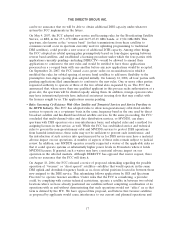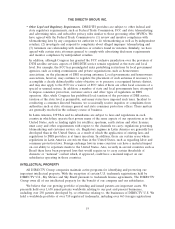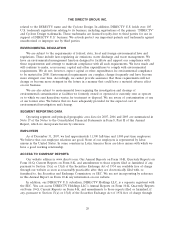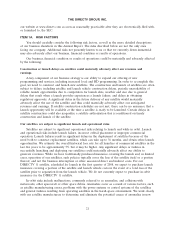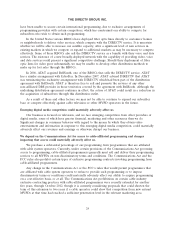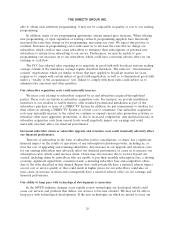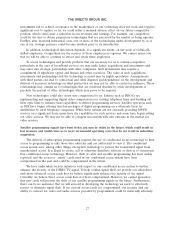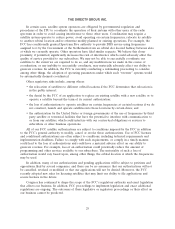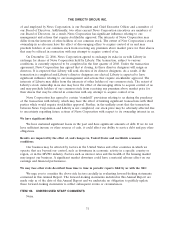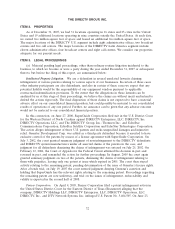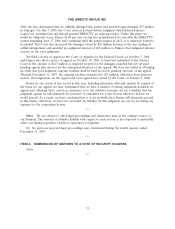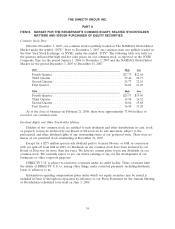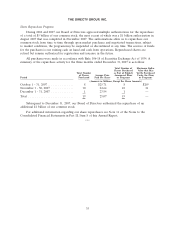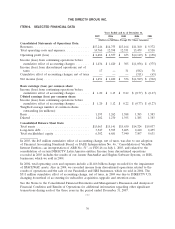DIRECTV 2007 Annual Report Download - page 36
Download and view the complete annual report
Please find page 36 of the 2007 DIRECTV annual report below. You can navigate through the pages in the report by either clicking on the pages listed below, or by using the keyword search tool below to find specific information within the annual report.THE DIRECTV GROUP, INC.
investments fail to achieve acceptance in the marketplace or our technology does not work and requires
significant cost to replace or fix, we could suffer a material adverse effect on our future competitive
position, which could cause a reduction in our revenues and earnings. For example, our competitors
could be the first to obtain proprietary technologies that are perceived by the market as being superior.
Further, after incurring substantial costs, one or more of the technologies under development by us or
any of our strategic partners could become obsolete prior to its introduction.
In addition, technological innovation depends, to a significant extent, on the work of technically
skilled employees. Competition for the services of these employees is vigorous. We cannot assure you
that we will be able to continue to attract and retain these employees.
To access technologies and provide products that are necessary for us to remain competitive,
particularly in the area of broadband services, we may make future acquisitions and investments and
may enter into strategic partnerships with other companies. Such investments may require a
commitment of significant capital and human and other resources. The value of such acquisitions,
investments and partnerships and the technology accessed may be highly speculative. Arrangements
with third parties can lead to contractual and other disputes and dependence on the development and
delivery of necessary technology on third parties that we may not be able to control or influence. These
relationships may commit us to technologies that are rendered obsolete by other developments or
preclude the pursuit of other technologies which may prove to be superior.
New technologies could also create new competitors for us. Entities such as RBOCs are
implementing and supporting digital video compression over existing telephone lines and building out
fiber optic lines to enhance their capabilities to deliver programming services. Satellite operators such
as SES have begun offering turn-key packages of digital programming on a wholesale basis for
distribution by rural telephone companies. While these entities are not currently providing MVPD
services on a significant basis, many have the capabilities for such services and some have begun rolling
out video services. We may not be able to compete successfully with new entrants in the market for
video services.
Satellite programming signals have been stolen and may be stolen in the future, which could result in
lost revenues and would cause us to incur incremental operating costs that do not result in subscriber
acquisition.
The delivery of subscription programming requires the use of conditional access technology to limit
access to programming to only those who subscribe and are authorized to view it. The conditional
access system uses, among other things, encryption technology to protect the transmitted signal from
unauthorized access. It is illegal to create, sell or otherwise distribute software or devices to circumvent
that conditional access technology. However, theft of cable and satellite programming has been widely
reported, and the access or ‘‘smart’’ cards used in our conditional access system have been
compromised in the past and could be compromised in the future.
We have undertaken various initiatives with respect to our conditional access system to further
enhance the security of the DIRECTV signal. To help combat signal theft, we provide our subscribers
with more advanced access cards that we believe significantly enhance the security of our signal.
Currently, we believe these access cards have not been compromised. However, we cannot guarantee
that new cards will prevent the theft of our satellite programming signals in the future. Furthermore,
there can be no assurance that we will succeed in developing the technology we need to effectively
restrict or eliminate signal theft. If our current access cards are compromised, our revenue and our
ability to contract for video and audio services provided by programmers could be materially adversely
27


